Australia’s COVID-19 cluster swells

A worker wearing mask cleans the tram station in CBD of Melbourne, Victoria, Australia, on Oct. 19, 2020. After more than three months of lockdown, metropolitan Melbourne moved from second step to third step of restrictions, and regional Victoria continues in third step with further easing of restrictions from midnight of Oct. 27. The whole state recorded zero new COVID-19 infection and virus-related death for a second day in a row on Oct. 27.Photo:Xinhua
Australia's second most populous state of Victoria, the epicenter of the country's latest coronavirus hot spot, reported 11 new cases of community transmission on Monday, taking the current cluster to 51.Victoria went into a strict seven-day lockdown on Friday after new COVID-19 infections in the state capital Melbourne ended its three-month run of zero community cases.
The state reported five new cases in the 24 hours to midnight. At a press conference in Melbourne on Monday, authorities announced a further six cases were recorded after the late night cut-off which will reflect in Tuesday's data.
The swelling numbers have raised questions over whether the lockdown will be extended beyond the seven days announced initially.
"The challenge ahead of us is a very, very significant one," Victorian acting Premier James Merlino told reporters.
The situation was "incredibly serious" and the next few days will be critical, Merlino added.
Medical officials have said the latest COVID-19 variant, first detected in India, was likely to be more virulent than the original strains, taking just one day to infect another person compared with earlier strains which can take about five or six.
Reuters
